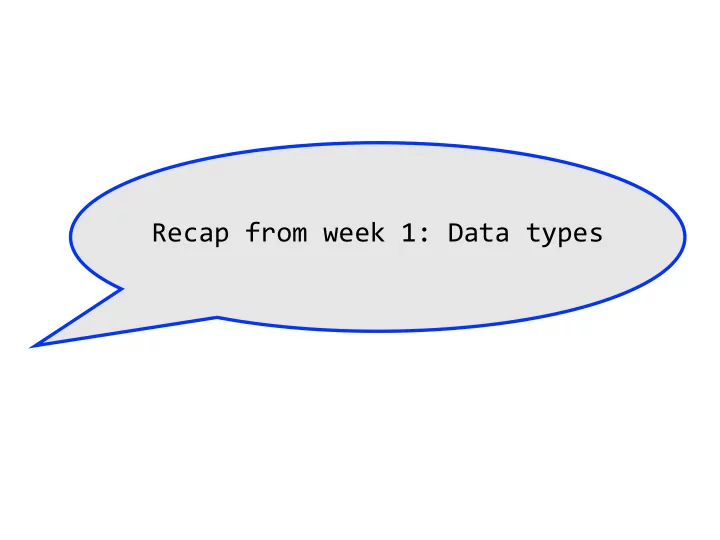

Recursive Datatypes and Lists Recap from week 1: Data types
Types and constructors data Suit = Spades | Hearts | Diamonds | Clubs Interpretation: “Here is a new type Suit . This type has four possible values: Spades , Hearts , Diamonds and Clubs .”
Types and constructors data Suit = Spades | Hearts | Diamonds | Clubs This definition introduces five things: – The type Suit – The constructors Spades :: Suit Hearts :: Suit Diamonds :: Suit Clubs :: Suit
Types and constructors data Rank = Numeric Integer | Jack | Queen | King | Ace Interpretation: “Here is a new type Rank . Values of this type have five possible possible forms: Numeric n , Jack , Queen , King or Ace , where n is a value of type Integer ”
Types and constructors data Rank = Numeric Integer | Jack | Queen | King | Ace This definition introduces six things: – The type Rank – The constructors Numeric :: ??? Jack :: ??? Queen :: ??? King :: ??? Ace :: ???
Types and constructors data Rank = Numeric Integer | Jack | Queen | King | Ace This definition introduces six things: – The type Rank – The constructors Numeric :: Integer → Rank Jack :: ??? Queen :: ??? King :: ??? Ace :: ???
Types and constructors data Rank = Numeric Integer | Jack | Queen | King | Ace This definition introduces six things: – The type Rank – The constructors Numeric :: Integer → Rank Jack :: Rank Queen :: Rank King :: Rank Ace :: Rank
Types and constructors data Rank = Numeric Integer | Jack | Queen | King | Ace Type Type Constructor
Types and constructors data Card = Card Rank Suit Interpretation: “Here is a new type Card . Values of this type have the form Card r s , where r and s are values of type Rank and Suit respectively.”
Types and constructors data Card = Card Rank Suit This definition introduces two things: – The type Card – The constructor Card :: ???
Types and constructors data Card = Card Rank Suit This definition introduces two things: – The type Card – The constructor Card :: Rank → Suit → Card
Types and constructors data Card = Card Rank Suit Type Type Type Constructor
Built-in lists data [a] = [] | (:) a [a] Not a legal definition, but the built-in lists are conceptually defined like this Constructors: [] :: [a] (:) :: a → [a] → [a]
Some list operations • From the Data.List module (also in the Prelude): reverse :: [a] -> [a] -- reverse a list take :: Int -> [a] -> [a] -- (take n) picks the first n elements (++) :: [a] -> [a] -> [a] -- append a list after another replicate :: Int -> a -> [a] -- make a list by replicating an element
Some list operations *Main> reverse [1,2,3] [3,2,1] *Main> take 4 [1..10] [1,2,3,4] *Main> [1,2,3] ++ [4,5,6] [1,2,3,4,5,6] *Main> replicate 5 2 [2,2,2,2,2]
Strings are lists of characters type String = [Char] Type synonym definition Prelude> 'g' : "apa" "gapa" Prelude> "flyg" ++ "plan" "flygplan" Prelude> ['A','p','a'] "Apa"
More on Types • Functions can have “general” types: – polymorphism – reverse :: [a] → [a] – (:) :: a → [a] → [a] • Sometimes, these types can be restricted – Ord a => … for comparisons (<, <=, >, >=, …) – Eq a => … for equality (==, /=) – Num a => … for numeric operations (+, -, *, …)
Do’s and Don’ts isBig :: Integer → Bool isBig n | n > 9999 = True | otherwise = False guards and boolean results isBig :: Integer → Bool isBig n = n > 9999
Do’s and Don’ts resultIsSmall :: Integer → Bool resultIsSmall n = isSmall (f n) == True comparison with a boolean constant resultIsSmall :: Integer → Bool resultIsSmall n = isSmall (f n)
Do’s and Don’ts resultIsBig :: Integer → Bool resultIsBig n = isSmall (f n) == False comparison with a boolean constant resultIsBig :: Integer → Bool resultIsBig n = not (isSmall (f n))
Do’s and Don’ts Do not make unnecessary case distinctions necessary case distinction? fun1 :: [Integer] → Bool fun1 [] = False fun1 (x:xs) = length (x:xs) == 10 repeated code fun1 :: [Integer] → Bool fun1 xs = length xs == 10
Do’s and Don’ts Make the base case as simple as possible right base case ? fun2 :: [Integer] → Integer fun2 [x] = calc x fun2 (x:xs) = calc x + fun2 xs repeated code fun2 :: [Integer] → Integer fun2 [] = 0 fun2 (x:xs) = calc x + fun2 xs
Recommend
More recommend